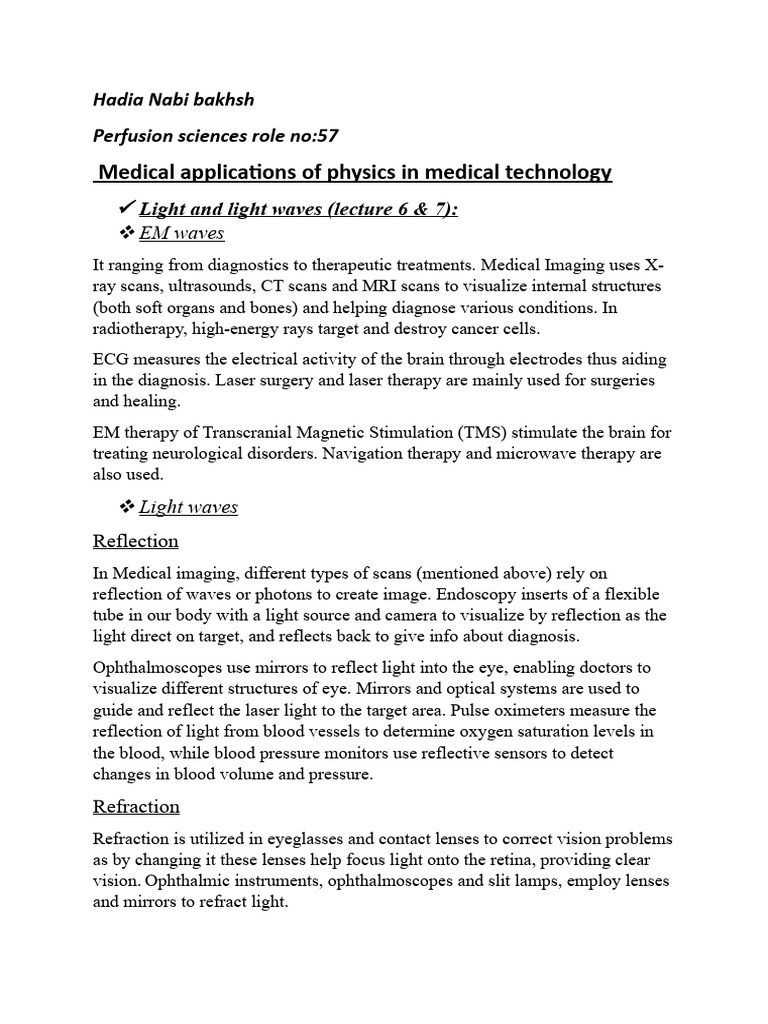The role of physics in medical laboratory technology cannot be overstated; it serves as the underpinning for numerous methodologies and practices utilized to ensure accurate diagnostics, effective treatments, and innovative research. Within the realm of healthcare, the intersection of physics and laboratory technology offers profound implications, enabling practitioners to harness the laws of nature to improve patient outcomes. This article seeks to unravel the intricate ways in which physics informs and enhances medical laboratory technology, extending from diagnostics to therapeutic interventions.
Understanding the contributions of physics begins with recognizing the fundamental principles that govern biomedical instrumentation. At the heart of many diagnostic tools lies the application of electromagnetic radiation, particularly in imaging techniques like X-rays, MRI (Magnetic Resonance Imaging), and CT (Computed Tomography) scans. These modalities leverage physical principles such as ionization, magnetism, and wave-particle duality to produce intricate images of the human body, allowing for the identification of pathological conditions that may otherwise remain undetected.
Take X-rays, for example; they exploit the differential absorption of radiation by various tissues. The underlying physics dictates that dense materials, such as bones, absorb more X-rays, thus appearing lighter on the developed image, while softer tissues appear darker. This principle not only assists in identifying fractures but also aids in diagnosing tumors and infections. The mastery of such techniques requires laboratory technicians to possess a thorough understanding of the physics involved, ensuring both safety for patients and precision in imaging.
Similarly, magnetic resonance imaging derives its efficacy from the principles of nuclear magnetic resonance. By placing patients within a strong magnetic field, specific atomic nuclei within the body resonate at distinct frequencies. The resultant signals, when processed, yield high-resolution images of soft tissues, facilitating the diagnosis of conditions ranging from brain disorders to musculoskeletal injuries. The sophisticated manipulation of electromagnetic waves in this context exemplifies how physics is instrumental in shaping diagnostic capabilities.
The realm of laboratory analysis is equally rich in the contributions of physics. Various analytical techniques, including spectrophotometry, utilize the principles of light interaction with matter. For instance, spectrophotometry identifies and quantifies substances based on their absorption spectra. When light passes through a sample, specific wavelengths are absorbed depending on the molecular structure of the analyte. By analyzing the resulting spectra, laboratory technicians can derive quantitative data pertinent to blood tests, urine analyses, and other bodily fluids. This coupling of light physics with biochemistry enables the detection of diseases, monitoring of drug levels, and assessments of metabolic functions.
Moreover, the meticulous field of laboratory diagnostics often relies on advanced physics concepts to ensure the accurate measurement of biological parameters. For instance, the application of thermodynamics in the calibration of laboratory instruments guarantees the reliability of results. Temperature control in incubators and analyzers is vital; fluctuations, however slight, can skew results, thus emphasizing the importance of stable thermal environments. Similarly, fluid dynamics plays a crucial role in the design of pipetting systems and microfluidic devices, which manipulate small volumes of liquids to carry out complex biological assays efficiently. By understanding these underlying principles, technicians can better operate and troubleshoot instrumentation, ensuring optimal performance.
Furthermore, advancements in physics have spurred the development of novel medical technologies, such as point-of-care testing devices. These innovations allow rapid analyses at the patient’s bedside, further integrating physics into clinical practice. The design of micro-scale devices that operate through the manipulation of fluid behavior—facilitated by the principles of physics—enhances efficiency and expedites diagnostic processes, allowing practitioners to make informed decisions promptly.
Beyond mere diagnostics, physics finds its way into the therapeutic landscape through techniques such as radiotherapy. Computational modeling and radiation physics are crucial in calculating the optimal doses and delivery methods of radiation to effectively target neoplastic cells while sparing surrounding healthy tissues. The synergy of physics with medical science thus not only facilitates diagnosis but also extends its reach to treatment modalities that improve survival rates and quality of life for patients undergoing cancer therapies.
The ongoing evolution of medical laboratory technology is inextricably linked to advancements in physics. Emerging fields such as nanotechnology and photonics hold promising prospects for the future of healthcare. The precise manipulation of materials on a nanoscale not only fosters the development of targeted drug delivery systems but also magnifies the potential for revolutionary diagnostic devices that provide real-time cellular analysis. As these interdisciplinary approaches gain traction, the role of physics in medical laboratory technology will continue to broaden, inviting innovations that were once considered the realm of science fiction.
In conclusion, the interplay of physics and medical laboratory technology is far from linear; it resembles a complex tapestry woven from diverse threads of scientific inquiry. It challenges the status quo, prompting a shift in perspective regarding the modern healthcare paradigm. By embracing the foundational principles of physics, medical professionals can unlock new pathways in diagnostics and treatments, ultimately transforming patient care. The role of physics in this domain must be recognized and celebrated, as it paves the way for future advancements that hold the promise of improved health outcomes for all.












